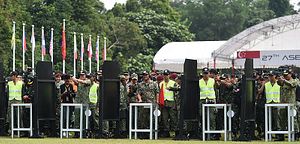On March 8, Singapore held this year’s iteration of the meeting of ASEAN defense chiefs. Though meeting was just one of a number of defense-related interactions that the city-state is hosting, it offered some sense of how Southeast Asian states view the region and what agenda items they are prioritizing.
As I have noted before, Southeast Asian states have a variety of defense engagements between them within the ASEAN framework, including the annual gatherings of defense ministers (ADMM), the chiefs of ASEAN police forces (ASEANAPOL), ASEAN chiefs of defense forces (ACDFIM), and the ASEAN navy chiefs (ANCM) (See: “What Did the ASEAN Defense Meetings in the Philippines Achieve?”).
On March 8, Singapore hosted the 15th iteration of the ACDFIM. There were a series of interactions tied to the meeting, including the ASEAN Military Intelligence Informal Meeting (AMIIM) and the ASEAN Military Operations Informal Meeting (AMOIM) that occurred on March 6. The formal ACDFIM itself was chaired by Lieutenant-General Perry Lim. There was also a breakfast meeting with Singapore’s Defense Minister Ng Eng Hen, and other bilateral meetings that took place on the sidelines between Southeast Asian defense officials.
The headlines that followed the meeting focused on the range of issues that usually gain attention, from the South China Sea disputes to terrorism, with the Islamic State continuing to pose a challenge to the region despite the end of the siege in the southern Philippine city of Marawi (See: “ASEAN’s Post-Marawi Islamic State Challenge”).The CDFs also touched on other issues such as strengthening the regional architecture around humanitarian assistance and disaster relief (HADR).
But there was also a further consideration of regional initiatives taking place, which have been of interest to ASEAN’s external partners as well. These include some measures that Singapore had signaled as key to its ASEAN chairmanship, such as the adoption of an agreement on air-to-air encounters, as well as more longstanding proposals such as one for an ASEAN-China Maritime Exercise, where specifics remain to be worked out (See: “What’s Behind the New ASEAN-China Maritime Exercise?”).
Beyond this, there was also reference to other ASEAN-specific initiatives within the meeting as well as at related fora, such as the new ASEAN Military Ready Group (AMRG) on HADR and the convening of the inaugural ASEAN Armies Information Sharing Workshop (AAISW) to enhance army capabilities to respond to chemical, biological, radiological, and nuclear (CBRN) domains. The AAISW was previously raised at the ASEAN Chiefs of Armies Multilateral Meeting, which Singapore had hosted last November as part of the lead up to its chairmanship this year.
The ministers also reaffirmed their intent to formalize the ACDFIM. The formalization is among the series of incremental moves that have been mulled to boost defense interactions between Southeast Asian states, including the annualization of the ASEAN Defense Ministers’ Meeting Plus (ADMM-Plus), which was announced last year.

































